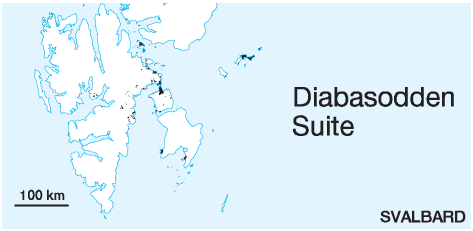 |
|
 |
|
Intrusive rocksfrom: Dallmann. W.K. (ed.). Svalbard lithostratigraphic lexiconDIABASODDEN SUITE (M-103)  DISTRIBUTION shown on figs.: 3-09, 3-10, 3-11, 3-12 (The suite occurs also on western Spitsbergen, but dikes there are too thin to be indicated on the respective maps.) STATUS OF UNIT: Formal FIRST USE OF NAME: Here CURRENT DEFINITION: Here SYNONYM(S) AND REFERENCE(S): The suite has been referred to as "Mesozoic dolerite sills and dikes" on published maps. ORIGIN OF NAME: Diabasodden (transl. "The Diabase Point"): A point on the southern coast of Sassenfjorden TYPE AREA: Diabasodden, northern Nordenskiöld Land INTRUSIVE AGE: Late Jurassic - Early Cretaceous DATING METHOD: Radiometric age determination, K-Ar method REFERENCE(S) FOR AGE: Burov et al. 1977 HOST ROCKS: Precambrian through to Lower Cretaceous OTHER USE OF NAME: None MAIN LITHOLOGIES: Dolerite DESCRIPTION: Dolerite dikes and sills cut strata of all ages up to early Cretaceous in most areas of Svalbard. In central and eastern Svalbard, where sediments of these ages are flat-lying, they cover major areas and often form top plateaus of table mountains or islands. The dolerite intrusions are generally considered to be of Cretaceous age, with one age distribution maximum at the Jurassic/Cretaceous boundary, and another one in the late Early Cretaceous (Burov et al. 1977). The minimum age of the host rocks decreases eastwards. The thickness of sills normally varies from a few metres to more than 50 m. The observed lateral extent of individual sills attains 10-15 km. They are oriented parallel with the bedding of the host rocks or slightly cut them, mostly at low angles. Forking of sills occurs frequently. Subvertical dikes occur, but are not observed frequently. The mineral composition of dolerites is: Plagioclase (An 40-80) 40-60%, clinopyroxene 30-50%, opaques (magnetite, pyrite) 5-20%. Secondary minerals are carbonate, chlorite and saussuritised plagioclase. A small amount (up to 2-3%) of quartz is recorded close to margins of intrusive bodies. Dolerites containing up to 10% olivine are reported from the Agardhbukta area (Panov et al. 1968, unpubl.). The central parts of intrusive bodies are mainly medium- to coarse-grained and show doleritic and, less commonly, ophitic textures. The peripheral parts are fine-grained and have a microdoleritic texture. In calcified marginal zones of the intrusive bodies, porphyritic and relic-doleritic matrix textures occur. The chemical composition is tholeiitic, partly oversaturated, and their REE patterns reflect a continental intraplate setting with a hot-spot affinity (Murosko 1981, unpubl.; Hauser 1982, unpubl.). Thermal effects around intrusions are essentially developed in shales and siltstones, where hornfelsing and calcification of the host rocks are observed. The thickness of these altered zones attains 2 m or, less commonly, up to 4 m, dependant on the thickness of the dolerites. Back on top |